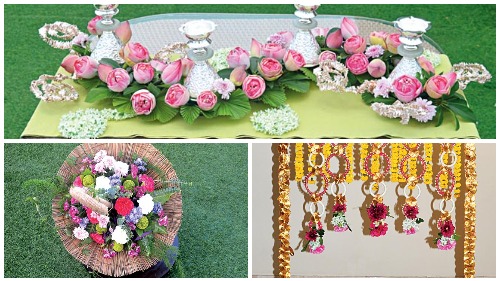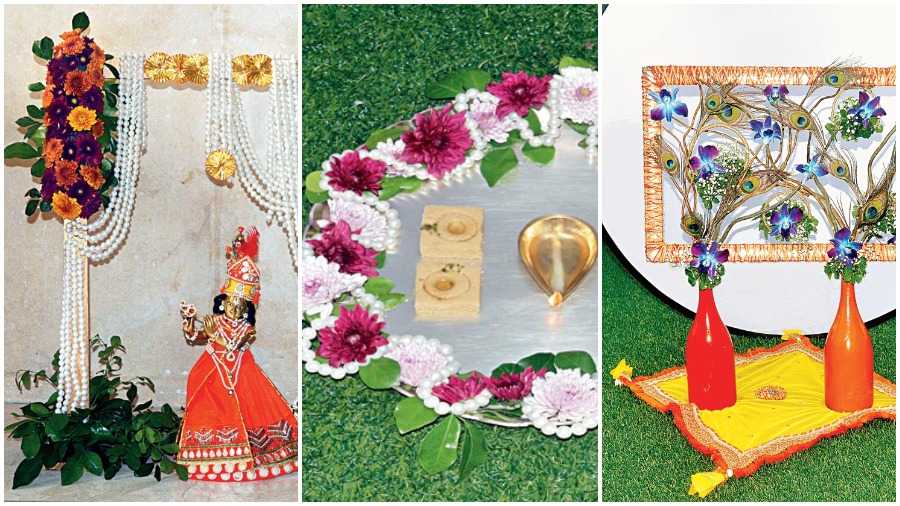Krishna Janmashtami or Gokulashtami is celebrated to commemorate the birth of the eighth son of Devaki on the eighth day of the dark fortnight of the month of Bhadrapada. We see a lot of children dressed up as Lord Krishna for plays, also known as Ras Leela. At some places Jhulotsava is a week-long celebration with daily chanting and beautiful flower decorations.
In Maharashtra, this day is observed with dahi-handi competitions that involve breaking a high-hung earthen pot filled with yoghurt, milk and fruits. Dwarka celebrates this day as Makan Handi, or earthern pot filled with butter.
Most Vaishnava homes will have at least a small Janmashtami celebration. One can create a jhula for the Laddoo Gopal or worship Lord Krishna creating a beautiful floral exhibit all around him.
A wooden frame in proportion to the size of the idol is taken and set around the beautifully dressed Lord Krishna. They are covered with gotapatti flowers on the top. The most impactful area of focus in this arrangement are the strings of white pearls used all over the frame. White pearls signify purity.
Two elongated clusters of chrysanthemum, kamini leaves and pearl are fixed at the top on one end and at the bottom on the other side, creating a vertical traditional line going upward and downwards. The scale of the components used on display implements various principles of design. A cluster of ficus leaves at the bottom balances the strong forms at the top of the arrangement. Involve the children at home to create this jhula form and you will be in for a surprise!

(Clockwise from above)Lotus offerings, Umbrella bloom , Floral torana
Lotus offerings
It is a table-top elongated-style composition of winding lines. The four traditionally crafted lamps are alternately placed within the perimeter of this design. Pink lotus (an important offering during all pujas) and similar coloured chrysanthemum flowers are fixed on the oasis. At the base, a large umbrella of palm and ficus leaves are fixed that make the pink flowers stand out. The natural horizontal winding movement creates rhythm and direction in this structure. To generate further harmony with the silver lamps, gota strips are threaded and pulled to produce scroll-like silver twirl rolls. They are placed on both sides, front and back. As it is a 360° design, the placements need to be balanced to further create harmony with fresh flowers. Juhi malas are clustered at various places, creating a combination of white and pink flowers.
Umbrella Bloom
This is an inverted umbrella. It is made of cleaned and dried thin broomsticks. It is tied with thin wire to keep the structure strong. After using this arrangement, it can be kept away for reuse at a later date. A round 18-inch cardboard piece is taken, a big slit is made and overlapped to make a conical form. The broomsticks structure is glued on both sides . The umbrella stick is inserted at the centre.
A soaked oasis is placed at the centre. Pastel-coloured flowers are largely used to make this bouquet. The flowers used are burf flowers, kadam flowers, and white and pink ixoras. A cluster of syngonium leaves is also used. The creepers added provide movement to this circular arrangement.
The balanced bunch of flowers assembled together gives a rhythmic circular motion to this conical pattern. They create interesting outward lines in this design. It is a freestyle design where all components of the design are assembled in exciting dynamic balance of the umbrella structure and all the flowers are assembled in the form of a bouquet. The contrast of textures intensifies their quality and emphasises all the components used.
Puja Thali
On religious occasions and festivals, as well as for traditional rituals, the puja thali, or platter of offerings, has an auspicious role. The platter can be of any metal — steel, silver, brass or gold, and is usually round or oval. One can observe a variety of offerings like turmeric/sindoor paste, akshata (unbroken rice grains), coconuts, flowers , sweets, holy water, small bells, conch shells — and the list can go on.
Here, a medium-sized silver plate has been decorated at the edge with dark pink and light pink carnations. Any flower, like roses or even lotus can be equally interesting and dynamic in this circular symmetrical design. The bright green leaves added create a positive connotation. For a floral artist, experimenting with colours with the tints, tones and shades that are found in nature’s palette is fascinating. The offerings in this platter are kept very simple with diya (lamp) and sweets. A long string of pearls entwined with the flowers is evocative of the structured traditional style. The beauty of this assembly creates both the focal point and rhythm in the finished work.
Through the window
I have fond memories of watching the dancing peacocks through the window during the monsoon at Vrindavan. Inspirations often are drawn from real-life experiences. This window frame has overlapping line designs which defy the long-held taboo that lines should not cross; rather, directional flows against one another create interest in the design. Two broad-based glass bottles/jars are painted in bright orange/red. An empty photo frame wrapped in coloured jute chords of red and orange creates colour harmony and becomes the symbolic window. Strong small handles at the bottom of this frame are inserted and tied to the mouth of the bottles. A framework of dried branches creates asymmetrical movement in this enclosure. Small rings wrapped in natural jute cord again are suspended at various places. Gypsophila, Aralia leaves and purple orchids are inserted in tiny oasis at the base of these rings. Some more orchids and peacock feathers are added to this arrangement. Since its time to celebrate the festival of Janmashtami, the peacock feather as part of the gear of Lord Krishna is important in creating colour deviation and contrasting texture in this design. A lovely shining satin traditional cloth at the bottom completes this arrangement.
Floral Torana
In ancient times a torana referred to a free-standing ornamental or arched gateway for ceremonial purposes. Today, symbolic toranas are made with locally available material like beads, jute, mirrors, fruits, flowers, lemons and leaves. It is said to bring good fortune, signify auspicious occasions or simply welcome guests.
This DIY torana is very easy to assemble and is made gorgeous with gotapatti flowers (easily available online) and strings of yellow marigold. On the sides of the door frame long strings of gotapatti flowers come down on each side, ending in a small cluster of umbrella palm leaves. From the top frame, a similar line of fresh yellow marigolds (one can also choose orange or even alternate yellow and orange) is hung. On top of these, bangles and rings of different sizes are tied with string. The joints are covered with single gotapatti to create harmony in this arrangement and a variety of fresh flowers like carnations are suspended at the bottom of these lines. These strong vertical lines create height, order and beauty.

Sunita Kanoria, trained at Pushpa Bitan, is a judge for national-level flower-arrangement competitions, and currently utilises her time and talent as a floral-decor demonstrator at various forums











